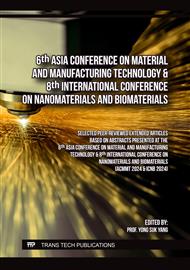[1]
M.A. Atieh, Y. Ji and V. Kochkodan, Metals in the Environment: Toxic Metals Removal, Bioinorganic Chemistry and Applications (2017) 4309198.
DOI: 10.1155/2017/4309198
Google Scholar
[2]
M. Jaishankar, T. Tseten, N. Anbalagan, B.B. Mathew and K.N. Beeregowda, Toxicity, mechanism and health effects of some heavy metals, Interdiscip Toxicol. 7 (2014), 60 -72.
DOI: 10.2478/intox-2014-0009
Google Scholar
[3]
Information on https://www.who.int/news-room/fact-sheets/detail/lead-poisoning-and-health
Google Scholar
[4]
Information on http://www.nbrienvis.nic.in/Database/1_2033.aspx
Google Scholar
[5]
A. Kumar, A. Kumar, M.M.S. Cabral-Pinto, A.K. Chaturvedi, A.A. Shabnam, G. Subrahmanyam, R. Mondal, D.K. Gupta, S.K. Malyan, S.S. Kumar, S.A. Khan and K.K. Yadav, Lead Toxicity: Health Hazards, Influence on Food Chain, and Sustainable Remediation Approaches, Int. J. Environ. Res. Public Health 17 (2020), 2179.
DOI: 10.3390/ijerph17072179
Google Scholar
[6]
C. Arpa and I. Aridasir, A Method to Determination of Lead Ions in Aqueous Samples: Ultrasound-Assisted Dispersive Liquid-Liquid Microextraction Method Based on Solidification of Floating Organic Drop and Back-Extraction Followed by FAAS, J. Anal. Methods Chem. (2018), 8951028.
DOI: 10.1155/2018/8951028
Google Scholar
[7]
J.Y. Cheon and W.H. Park, Green Synthesis of Silver Nanoparticles Stabilized with Mussel-Inspired Protein and Colorimetric Sensing of Lead(II) and Copper(II) Ions, Int. J. Mol. Sci. 17 (2016), 2006.
DOI: 10.3390/ijms17122006
Google Scholar
[8]
A. Rohaizad, Z.A. Mohd Hir, U.A.A.M. Kamal, Z. Aspanut and A.A. Pam, Biosynthesis of silver nanoparticles using Allium sativum extract assisted by solar irradiation in a composite with graphene oxide as potent adsorbents, Results in Chem. 5 (2023), 100731.
DOI: 10.1016/j.rechem.2022.100731
Google Scholar
[9]
B.R.A. Crieta, A.P.P. Tuaño, M.A.O. Torio, J.C. Villanueva, P.J. V. Gaban and K.A.T. Castillo-Israel, In vitro lipid-lowering properties of the fruits of two bignay [Antidesma bunius (L.) Spreng] cultivars as affected by maturity stage and thermal processing, Food Chem.: Mol. Sci. 2 (2021), 100020
DOI: 10.1016/j.fochms.2021.100020
Google Scholar
[10]
M. Kassem, A.N. Hashim and H. Hassanein, Bioactivity of Antidesma bunius leaves (Euphorbiaceae) and their major phenolic constituents, Eur. Sci J. 9 (2013), 217-228.
Google Scholar
[11]
K.I. Duerme, C. Montano, E. Diamante, N.G. Fundador, Eco-friendly Synthesis of Silver Nanoparticles using Bignay (Antidesma bunius) Leaves for Antibacterial Application, Curr. Nanomater. 10 (2025), 241023222574.
DOI: 10.2174/0124054615269442231016073205
Google Scholar
[12]
M. Ali, B. Kim, K.D. Belfield, D. Norman, M. Brennan and G.S. Ali, Green synthesis and characterization of silver nanoparticles using Artemisia absinthium aqueous extract — A comprehensive study, Mater. Sci. Eng. C. Mater. Biol. Appl. 58 (2016), 359-365.
DOI: 10.1016/j.msec.2015.08.045
Google Scholar
[13]
Y. Li, Q. Liao, W. Hou and L. Qin, Silver-Based Surface Plasmon Sensors: Fabrication and Applications, Int. J. Mol. Sci. 24 (2023), 4142.
DOI: 10.3390/ijms24044142
Google Scholar
[14]
J.A. Asong, E.K. Frimpong, H.A. Seepe, L. Katata-Seru, S.O. Amoo and A.O. Aremu, Green Synthesis of Characterized Silver Nanoparticle Using Cullen tomentosum and Assessment of Its Antibacterial Activity, Antibiotics 12 (2023), 203.
DOI: 10.3390/antibiotics12020203
Google Scholar
[15]
K. Nemčeková, V. Svitková, J. Sochr, P. Gemeiner and J. Labuda, Gallic acid-coated silver nanoparticles as perspective drug nanocarriers: bioanalytical study, Anal. Bioanal. Chem. 414 (2022), 5493.
DOI: 10.1007/s00216-022-03955-2
Google Scholar
[16]
G.S. Ghodake, S.K. Shinde, R.G. Saratale, A.A. Kadam, G.D. Saratale, A. Syed, F. Ameen and D.Y. Kim, Colorimetric detection of Cu2+ based on the formation of peptide–copper complexes on silver nanoparticle surfaces, Beilstein J. Nanotechnol. 9 (2018), 1414-1422.
DOI: 10.3762/bjnano.9.134
Google Scholar
[17]
S. Ershadi and A. Shayanfar, Are LOD and LOQ Reliable Parameters for Sensitivity Evaluation of Spectroscopic Methods?, J. AOAC Int. 101 (2018), 1212-1213.
DOI: 10.5740/jaoacint.17-0363
Google Scholar
[18]
N.H. Ibrahim, G.M. Taha, N.S.A. Hagaggi and M.A. Moghazy, Green synthesis of silver nanoparticles and its environmental sensor ability to some heavy metals, BMC Chem. 18 (2024)
DOI: 10.1186/s13065-023-01105-y
Google Scholar
[19]
M. Zannotti, S. Piras, L. R. Magnaghi, R. Biesuz and R. Giovannetti, Silver nanoparticles from orange peel extract: Colorimetric detection of Pb2+ and Cd2+ ions with a chemometric approach, Spectrochim. Acta Part A Mol. Biomol. Spectrosc. 323 (2024), 124881.
DOI: 10.1016/j.saa.2024.124881
Google Scholar



